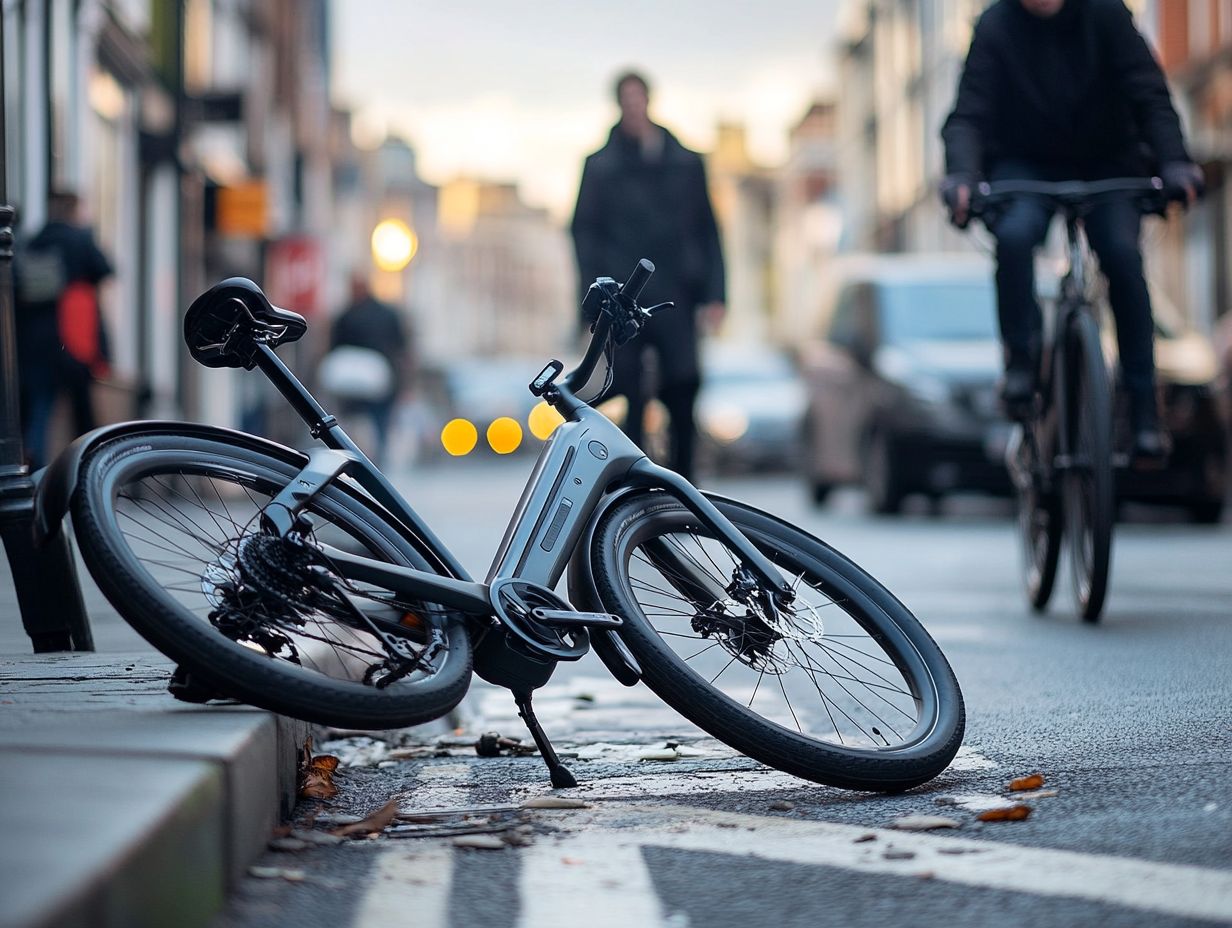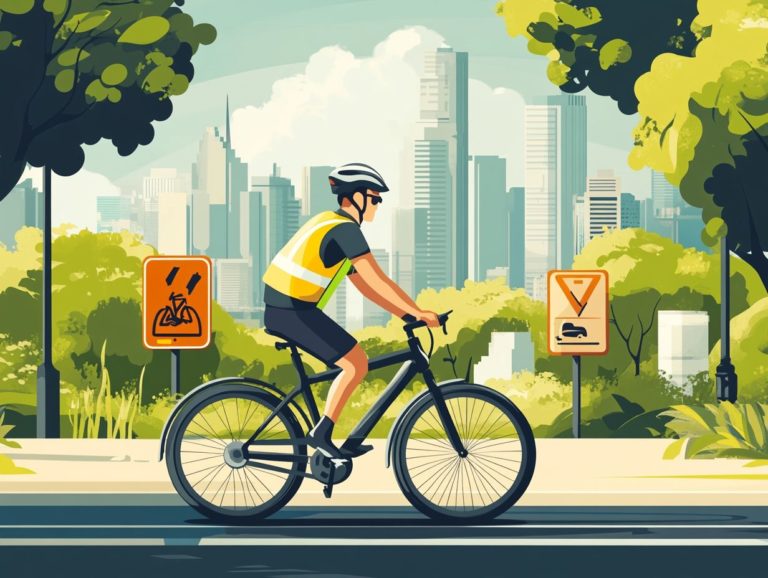Liability Issues for Electric Bicycle Accidents
Electric bicycles are swiftly becoming a favored choice, presenting you with a convenient and eco-friendly way to get around.
As their popularity rises, so too do the risks that come with them. This overview delves into electric bicycles, defining and classifying them while examining the common causes of accidents.
It also addresses liability concerns, potential legal ramifications, and essential safety measures that can help you steer clear of incidents. Grasping the nuances of insurance coverage for electric bicycles is vital for responsible riding.
Let s dive in there s a lot to learn about e-bikes!
Contents
- Key Takeaways:
- Overview of Electric Bicycles
- Common Causes of Electric Bicycle Accidents
- Liability in Electric Bicycle Accidents
- Potential Legal Consequences
- Preventing Electric Bicycle Accidents
- Insurance Coverage for Electric Bicycles
- Frequently Asked Questions
- What are liability issues for electric bicycle accidents?
- Who can be held liable for electric bicycle accidents?
- What factors can affect liability in electric bicycle accidents?
- Can the rider be held liable for an electric bicycle accident?
- What if the accident was caused by a defect in the electric bicycle?
- What steps can I take to protect myself from liability in electric bicycle accidents?
Key Takeaways:

- Electric bicycles are a growing trend, but their unique features pose liability concerns in the event of an accident.
- Determining fault and responsibility in electric bicycle accidents can be complex, considering both human error and equipment malfunction, especially regarding injuries to pedestrians.
- It is important for electric bicycle riders to understand their insurance coverage options and take necessary safety measures to prevent accidents and potential legal consequences.
Overview of Electric Bicycles
Electric bicycles, or e-bikes as they re commonly known, have seen an impressive surge in popularity in California and around the world because of advancements in electric motor technology that enhance your biking experience.
You ll find these bicycles categorized into three classes:
Class 1 E-Bikes provide pedal-assist only; Class 2 E-Bikes give you throttle assistance; and Class 3 E-Bikes are designed for those who crave higher speeds. This variety caters to a diverse range of riders and commuting preferences.
The booming e-bike market thrives on a vibrant biking community that champions responsible riding and adherence to safety regulations, ensuring everyone can enjoy the ride.
Definition and Classification
An e-bike is a bicycle with an electric motor that helps you pedal, making it easier to ride longer distances and go up hills more easily. These electric bicycles are crafted from several key components: a battery that stores energy for the motor, a controller that manages the power flow from the battery, and an array of sensors that gauge your pedaling force, ensuring safety for all operators.
E-bikes come in various classifications, each catering to different riding preferences:
- Class 1: This type provides assistance only while you re pedaling and typically caps out at 20 mph, making it an excellent choice for school routes.
- Class 2: With the addition of a throttle for power on demand, this class also has a 20 mph limit, suitable for rentals and recreational use.
- Class 3: Designed for those who crave speed, these bikes can reach up to 28 mph and often require you to don a helmet. It’s crucial for you to familiarize yourself with the specific laws governing these classifications, as regulations can differ considerably from state to state. In California, for example, the rules may dictate where each class is permitted to ride.
Common Causes of Electric Bicycle Accidents
Even as electric bicycles continue to gain traction, it s essential to recognize the inherent risks. Accidents can happen all too easily, often stemming from a mix of human error and equipment malfunction, resulting in injuries for both riders and pedestrians.
Wearing safety gear is very important, and practicing responsible riding behavior cannot be emphasized enough. These elements are crucial in preventing unfortunate incidents on the road and mitigating the risks associated with electric bikes.
Don t wait! Understanding these safety measures can protect you and others while riding your e-bike.
Human Error and Equipment Malfunction
Human error, such as distracted riding or ignoring traffic laws, is a leading cause of electric bicycle accidents. This often results in serious injuries for both riders and pedestrians.
Consider this: riders may miss critical signals, misjudge distances, or become overly confident in their handling skills. All these factors can lead to perilous situations.
Research shows that nearly 40% of bicycle crashes stem from a lack of awareness while navigating busy streets. Equipment malfunctions also complicate these incidents. Issues like brake failures or battery problems highlight the necessity for regular maintenance.
To reduce these risks, regular maintenance is crucial. Think of routine checks on brake systems and battery performance. Experts emphasize that safety checks can significantly lower the risk of accidents. Statistics suggest that well-maintained bicycles can reduce accident rates by up to 30%.
Liability in Electric Bicycle Accidents

Determining liability in electric bicycle accidents can be intricate. It often hinges on various factors, including negligence the failure to take reasonable care and the behavior of everyone involved, including bicycle owners.
These factors can greatly influence personal injury claims and the extent of insurance coverage, especially concerning an umbrella policy.
Determining Fault and Responsibility
In electric bicycle accidents, determining fault requires analyzing the behavior of each party involved. Assess who acted irresponsibly or negligently, as this impacts liability.
This investigation typically relies on key methods: witness statements, police reports, and knowledge of local traffic laws. For instance, if a cyclist and a motorist collide, eyewitness accounts can clarify the actions leading up to the accident.
They can help determine whether the e-bike rider followed traffic signals or if the vehicle operator made an illegal maneuver. This often requires legal expertise.
Police reports offer an objective account that can significantly affect liability. In some cases, liability can shift. For example, if a car swerves to avoid a pedestrian and inadvertently hits the cyclist, the pedestrian may share some responsibility.
Real-life cases illustrate this complexity. Fault may not always lie with one party alone; it often results from a combination of behaviors that contribute to the unfortunate outcome. This is particularly true when considering both bicycle and motor vehicle operators.
Potential Legal Consequences
The potential legal consequences of electric bicycle accidents can be serious. They often lead to lawsuits seeking compensation for injuries, damages, and liability claims against those deemed responsible, including homeowners and operators.
Understanding these implications is crucial. Navigating these situations can significantly impact your rights and recovery options, especially regarding insurance.
Lawsuits and Compensation
In the unfortunate event of an electric bicycle accident, you will need to navigate the legal landscape to seek compensation for personal injuries and damages incurred, especially if you are involved in a rental.
Your first move should be to gather evidence and carefully write down your injuries. Consult with a personal injury attorney, such as those from Bourassa Law Group, who has expertise in e-bike cases. Once you’ve assessed your situation, the lawyer will help you file a complaint in the appropriate court. This complaint will detail your case against the defendant, including the incident, the extent of your injuries, and the types of compensation you’re pursuing.
You may encounter challenges along the way, such as proving responsibility for the accident, especially if there is contention over who caused it or if local laws concerning e-bikes introduce complications. It’s important to be aware of key legal considerations for electric bicycle riders. Compensation can cover medical expenses, damages for emotional distress, and lost earnings. The amount depends on the severity of your injuries and the strength of the evidence you present to support your claims.
Preventing Electric Bicycle Accidents
Preventing electric bicycle accidents requires a proactive approach on your part. Emphasize responsible behavior and implement safety measures designed to protect both you and pedestrians on the roads.
By prioritizing safety, you contribute to a smoother experience for everyone sharing the space, promoting a healthier biking community.
Safety Measures and Tips

As an electric bicycle rider, you need to pay attention to essential safety measures. This includes wearing the right safety gear, performing regular maintenance checks, and practicing responsible riding to minimize the risk of accidents.
Investing in high-quality safety gear is paramount for your protection. Ensure your helmet fits snugly and meets safety standards, ideally featuring visors to shield you from the sun and rain. Reflective clothing enhances visibility, particularly during low-light conditions, allowing others to spot you from a distance.
Don’t forget to equip your e-bike with front and rear lights; they are essential for safe nighttime rides.
Routine maintenance is non-negotiable. Regularly check your brakes and tire pressure to prevent unexpected malfunctions on the road. Adhering to responsible riding practices such as obeying traffic signals and being mindful of pedestrians will significantly elevate your overall safety experience.
Insurance Coverage for Electric Bicycles
Understanding the intricacies of insurance coverage for electric bicycles is essential for riders. It serves as a crucial safeguard against liability and personal injury claims should an accident occur, providing peace of mind for bike owners.
Being well-informed ensures that you’re adequately protected on the road. This allows you to ride with confidence and peace of mind.
Understanding Coverage Options
As an electric bicycle owner, it s wise to explore a range of insurance coverage options tailored to your needs. This includes liability policies that shield you from potential risks linked to accidents and injuries.
These policies can cover medical expenses if you harm another person or their property, providing you peace of mind as you navigate the roads. Comprehensive insurance is equally crucial, safeguarding you against damages from theft, vandalism, or natural disasters.
For instance, if your e-bike is stolen while parked, this coverage can reimburse you for the loss, alleviating the financial strain.
Consider also the value of umbrella policies, which offer an additional layer of protection by extending your liability coverage beyond the limits of standard policies. This way, you can ride without worry against unexpected legal claims or expenses that could arise from accidents.
Adopting this holistic approach to insurance can instill a sense of confidence in you as an e-bike enthusiast, allowing you to fully immerse yourself in the joy of your rides.
Frequently Asked Questions
What are liability issues for electric bicycle accidents?
Liability issues for electric bicycle accidents are about who is responsible by law if an accident happens. This can involve both civil and criminal responsibilities.
Who can be held liable for electric bicycle accidents?

The responsible parties can vary. It may include the rider, the manufacturer or seller of the electric bicycle, and other drivers who contributed to the accident.
What factors can affect liability in electric bicycle accidents?
Several factors can influence liability. These include negligence, breaking traffic laws, defective equipment, and poor maintenance of the electric bicycle.
Can the rider be held liable for an electric bicycle accident?
Yes, the rider can be held liable if they were careless or broke traffic laws. This includes riding under the influence or ignoring traffic signals.
What if the accident was caused by a defect in the electric bicycle?
If a defect caused the accident, the manufacturer or seller might be responsible for injuries or damages. This is known as product liability, meaning they’re accountable for faulty products.
What steps can I take to protect myself from liability in electric bicycle accidents?
To protect yourself, follow traffic laws and maintain your electric bicycle well. It s smart to have liability insurance for your electric bicycle.




